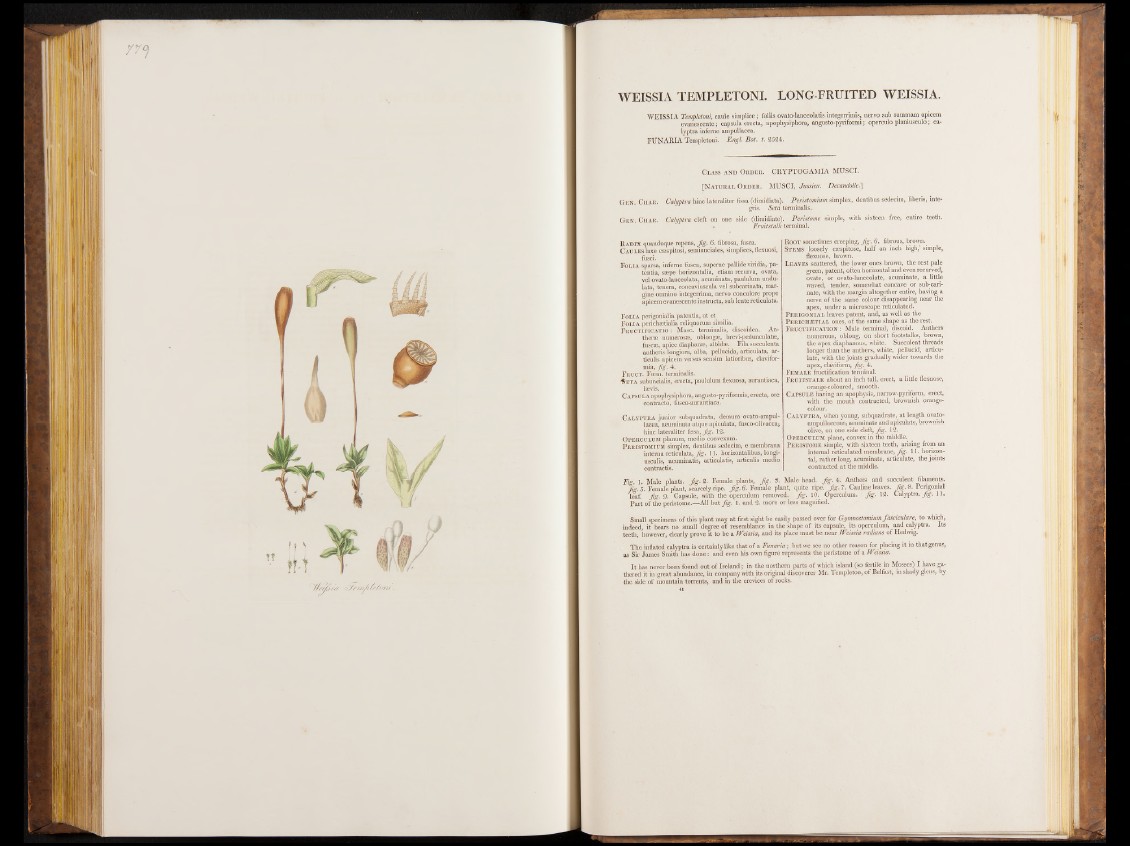
WEISSIA TEMPLETONI. LONG-FRUITED WEISSIA.
WEISSIA Templetoni, caule simplice ; foliis ovato-laneeolatis integerrimis, nervo sub summam apicem |||
evanescente ; capsula erecta, apophysiphora, angusto-pyriformi ; operculo planiusculo ; ca-
lyptra inferne ampullacea.
FUNARIA Templetoni. E n g l Bot. t. 2524.
Class and Order. CRYPTOGAMIA MUSCI.
[N atural Order. MUSCI, Jussieu. Decandolle.]
Gen. Guar. Calyptra hinc lateraliter fissa (dimidiata). ' Peristomium simplex, dentibus sedecim, liberis, inte-
gris. Seta terminals.
Gen . Char. Calyptra cleft on one side (dimidiate). Peristome simple, with sixteen free, entire teeth.
• Fruitstalk terminal.
R ad ix quandoque repens, Jig. 6. fibrosa, fusca.
C aules laxe cajspitosi, semiunciales, simplices, flexuosi,
fusci.
Folia sparsa, inferne fusca, superne pallide viridia, pa-
tentia, stepe horizontalia, etiam recurva, ovata,
vel ovato-lanceolata, acuminata, paululum undu-
lata, tenera, concaviuscula vel subcarinata, mar-
gine omnino integerrima, nervo concolore prope
apicem evanescente instructa, sub lente reticulata.
Folia perigonialia patentia, ut et
Folia perichsetialia reliquorum similia.
FruCTIEICATIO : Masc. terminalis, discoidea. Anther
® numerosEe, oblongte, brevi-pedunculatse,
fuse®, apice diaphan®, albidae. Fila succulenta
antheris loDgiora, alba, pellucida, articulata, ar-
ticulis apicem versus sensim' latioribus, clavifor-
mia, fig. 4.
Fruct. Foem. terminalis.
■fteta subuncialis, erecta, paululum flexuosa, aurantiaca,
lsevis.
Capsula apophysiphora, angusto-pyriformis, erecta, ore
contractor fusco-aurantiaca.
Calyptra junior subquadrata, demum ovato-ampul-
lacea, acuminata atque apiculata, fusco-olivacea,
hinc lateraliter fissa. Jig. 12.
Operculum planum, medio convexum.
Peristomium simplex, dentibus sedecim, e membrana
interna reticulata, fig . 11. horizontalibus, longi-
usculis, acuminatis, articulatis, articulis medio
contractis.
Root sometimes creeping, Jig. 6. fibrous, brown.
Stems loosely aespitose, half an inch high,’ simple,
flexuose, brown.
Leaves scattered, the lower ones brown, the rest pale
green, patent, often horizontal and even recurved,
ovate, or ovato-lanceolate, acuminate, a little
waved, tender, somewhat concave or sub-carinate,
with the margin altogether entire, having a
nerve of the same colour disappearing near the
apex, under a microscope reticulated.
Perigonial leaves patent, and, as well as the
Pe RICH2ETIal ones, of the same shape as the rest.
Fructification : Male terminal, discoid. Anthers
numerous, oblong, on short footstalks, brown,
the apex diaphanous, white. Succulent threads
longer than the anthers, white, pellucid, articulate,
with the joints gradually wider towards the
apex, claviform, fig. 4.
Female fructification terminal.
Fruitstalk about an inch tall, erect, a little, flexuose,
orange-coloured, smooth.
Capsule having an apophysis, narrow-pyriform, erect,
with the mouth contracted, brownish orange-
colour.
Calyptra, when young, subquadrate, at length ovato-
ampullaceous, acuminate and apiculate, brownish
olive, on one side cleft, jig . 12.
Operculum plane, convex in the middle. _
Peristome simple, with sixteen teeth, arising from an
internal reticulated membrane,^. 1 1 . horizontal,
rather long, acuminate, articulate, the joints
contracted at the middle.
Fig. 1. Male plants. Jig. 2. Female plants, Jig. 3. Male head. Jig. 4. Anthers and succulent filaments.
jig . 5. Female plant, scarcely ripe. Jig. 6. Female plant, quite ripe. Jig. 7'. Cauline leaves, fig . 8. Perigonial
leaf. Jig. 9. Capsule, with the operculum removed. Jig. 10. Operculum, fig . 12. Calyptra. fig . 11,
Part o f the peristome.—All but fig . 1. and 2. more or less magnified.
Small specimens of this plant may a t first sight be easily passed over for Gymnostomium fasciculare, to which,
indeed, it bears no small degree o f resemblance in the shape of its capsule, its operculum, and calyptra. Its
teeth, however, clearly prove it to be a JVeissia, and its place must be near JVeissia radians of Hedwig.
The inflated calyptra is certainly like that of a Funaria; but we see no other reason for placing it in that genus,
as Sir James Smith has done: and even his own figure represents the peristome of a JVeissia.
I t has never been found out of Ireland; in the northern parts of which island (so fertile in Mosses) I have gathered
it in great abundance, in company with its original discoverer Mr. 1 empleton, of Belfast, m shady glens, by
the side' of mountain torrents, and in the crevices o f rocks.
41